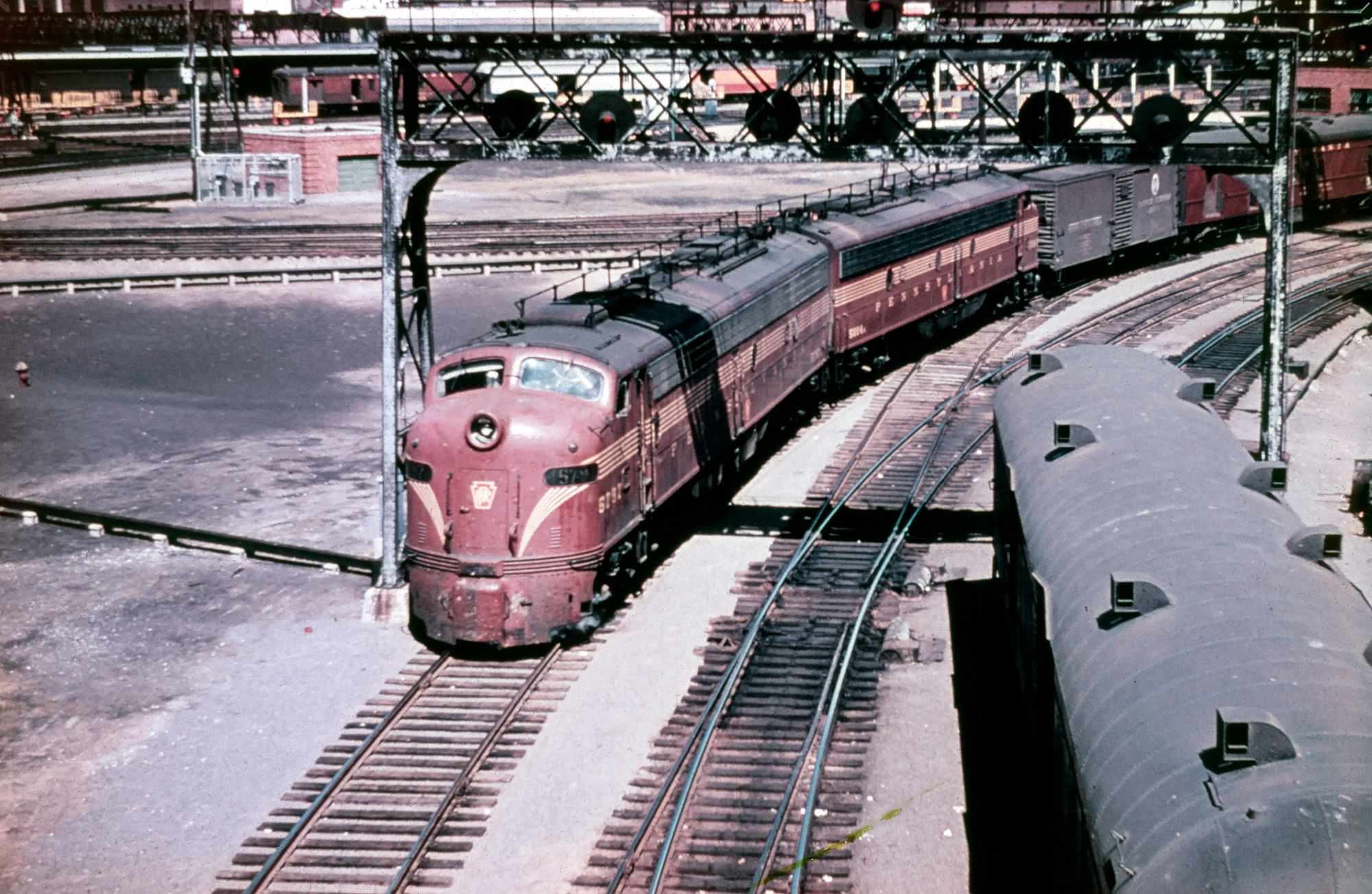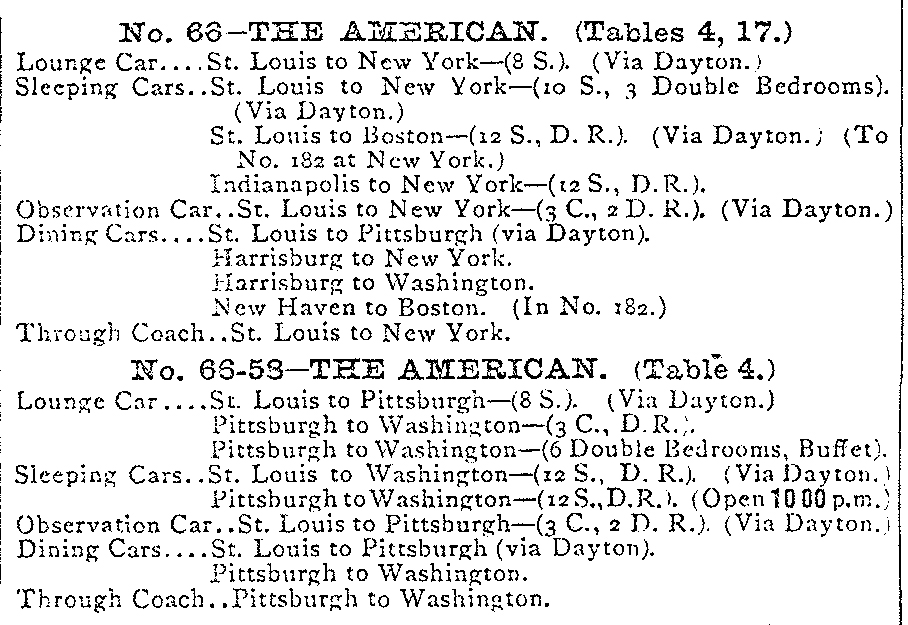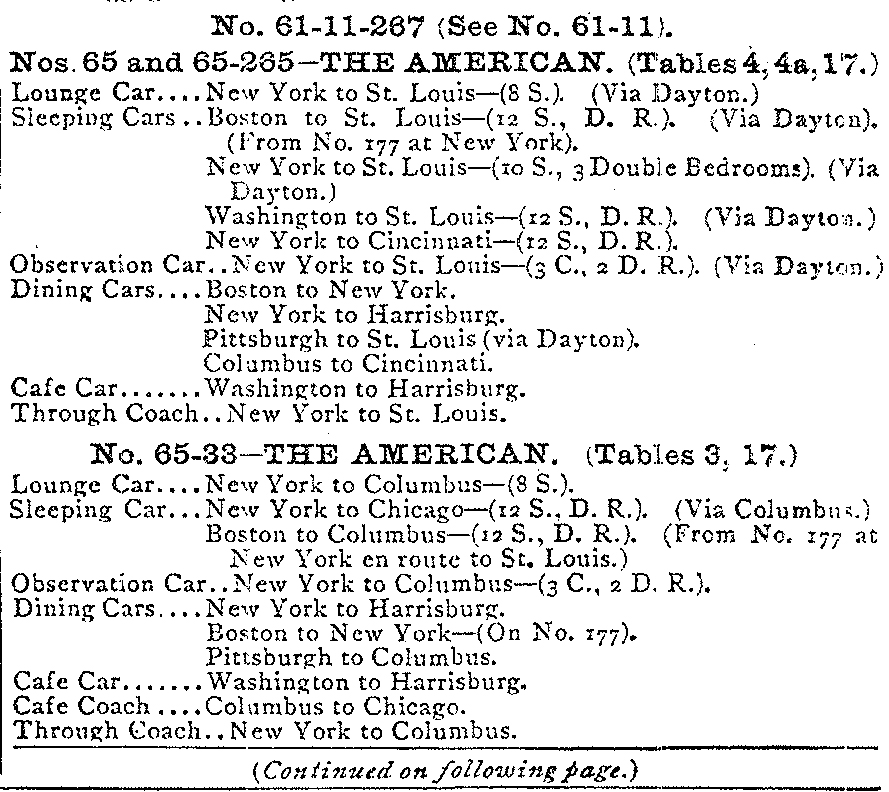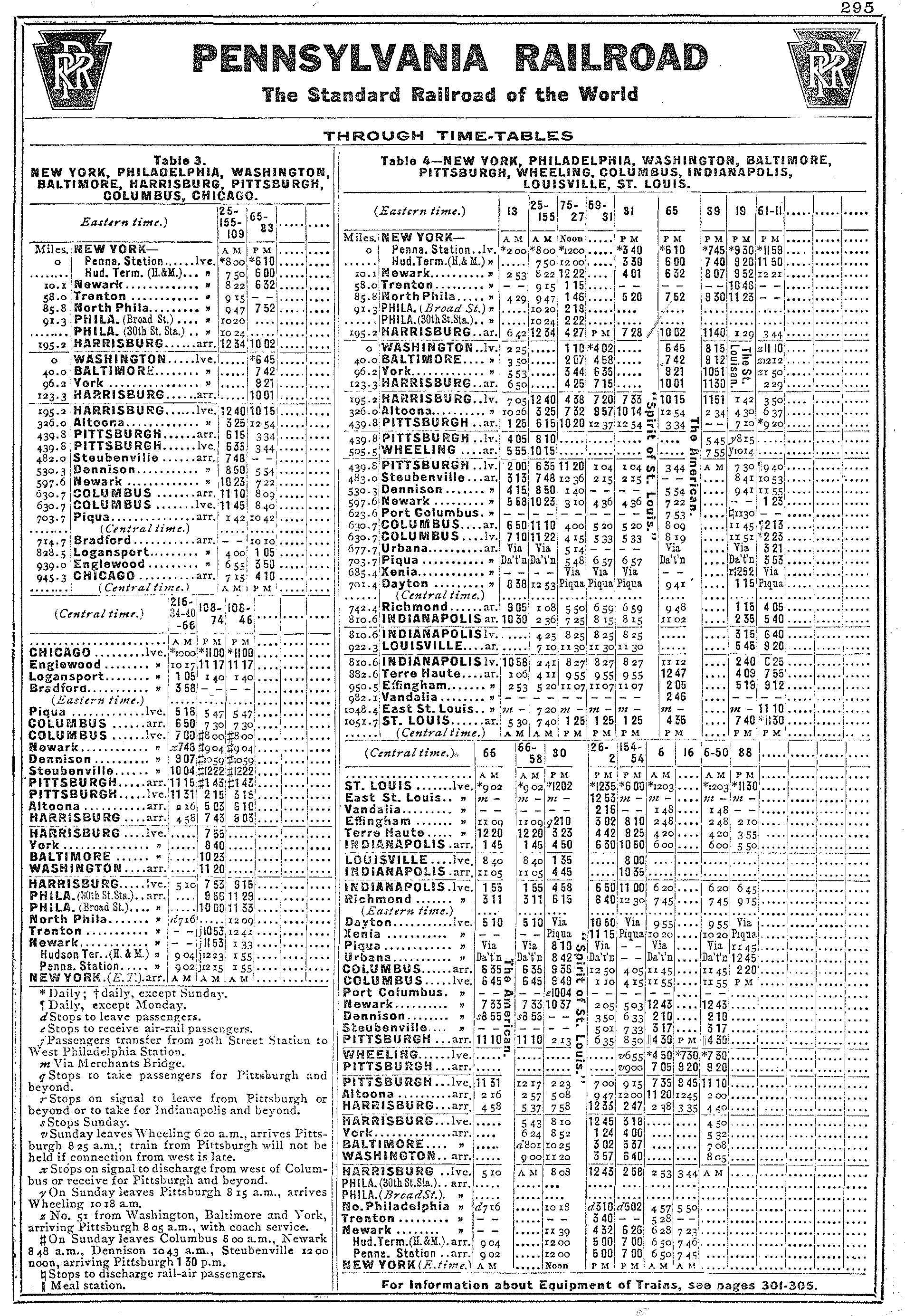The "American": New York - St. Louis [1925-1956]
Last revised: September 15, 2024
By: Adam Burns
The American was a long-running Pennsylvania Railroad train, which connected New York and St. Louis. It was launched in 1925 to compete with the Baltimore & Ohio's National Limited.
Into the streamliner era, the Pennsy fielded an increasing number of new trains as part of its "Blue Ribbon Fleet," especially along its St. Louis corridor.
As a result, names like the Spirit of St. Louis, Penn Texas, and even the regional Pittsburgher (New York-Pittsburgh) overtook The American in prestige and status.
With the railroad's declining postwar financial state, and the route already served by numerous other trains, The American was finally discontinued on April 28, 1956.
Photos
 Pennsylvania E8As #5797 and #5804A have the eastbound "American" departing St. Louis Union Station on August 31, 1955. American-Rails.com collection.
Pennsylvania E8As #5797 and #5804A have the eastbound "American" departing St. Louis Union Station on August 31, 1955. American-Rails.com collection.National Limited
The Baltimore & Ohio and Pennsy had a long-running competition in the Chicago-New York passenger market dating back to the late 19th century. While the B&O was no match for the PRR's faster schedules and luxurious first-class services, the Baltimore road nevertheless continually battled for its share of the business.
The B&O, which could not offer the Pennsy's direct service into New York, had better success in the Washington/Baltimore-Chicago corridor. On May 13, 1923 it upgraded its services on this route by launching the all-Pullman Capitol Limited, which replaced the former New York-Chicago Limited.
The B&O's 20-hour, Baltimore-Chicago leg - which also reached New York via Philadelphia - reduced the schedule by 2 hours. It was an immediate success.
As Joe Welsh notes in his book, "Baltimore & Ohio's Capitol Limited and National Limited," encouraged by this - and led by the company's most influential president, Daniel Willard - the railroad took aim at the Washington-St. Louis market by launching the National Limited on April 26, 1925.
Consist (1933)
While the train did not serve the larger cities of its counterpart - notably Chicago - it nevertheless featured the same level of first-class accommodations including a Pullman baggage club with barber-valet, a maid-manicurist, and train secretary. It also offered palor service between New York-Washington and Cincinnati-St. Louis.
The all-Pullman National Limited featured only sleeping cars - no coaches - and exquisite dining in one of the B&O's fabulous heavyweight "Colonial" diners. It was a fine train and upgraded accordingly in the streamliner era.
Inauguration
Not to be outdone by what it always believed was a second-rate competitor, the PRR launched The American on the same day, April 26, 1925. At the time the PRR considered the train its top service between New York-Pittsburgh-Dayton-Indianapolis-St. Louis.
Listed as trains #65/66, this heavyweight train was all first-class, extra-fare and included a club car, sleeper-observation, diner, and 12-section, 1 drawing room sleeper at various points along the route.
The Pennsy also provided connecting service to Washington, D.C. which included a club car, sleepers, and diner. Alas, its lofty status was short-lived when the PRR launched the Spirit of St. Louis in June, 1927 along the same corridor. The Spirit quickly eclipsed its counterpart, especially when it was streamlined in 1938.
Spirit of St. Louis
The Spirit of St. Louis officially entered service on June 15, 1927. The train was named after the airplane flown by Charles Lindbergh, who had completed the first nonstop transatlantic flight just a month earlier.
As the PRR’s premier train between New York and St. Louis, the Spirit of St. Louis provided a crucial link between two major American cities. It was touted as the “luxury trail for traveling executives” for its premium services and comfort, offering an elite travel experience.
The train connected numerous cities along the route. From New York, it passed through Philadelphia and Pittsburgh in Pennsylvania, Columbus in Ohio, and Indianapolis in Indiana, finally terminating in St. Louis, Missouri.
The Spirit of St. Louis was recognized in the PRR timetable by the train numbers 30 (eastbound) and 31 (westbound).
The on-board services offered were some of the finest in the era. These services included reclining seat coaches, a full dining car, Pullman sleeping cars, and even a buffet-lounge car.
Covering the distance between New York City and St. Louis, the Spirit of St. Louis travelled approximately 1,056 miles during each trip—a testament to the grand size of the PRR network.
The Spirit of St. Louis was emblematic of the PRR's larger "Blue Ribbon Fleet" of streamliners. These trains, with their sleek design and high-speed capacity, reflected the railroad's commitment to innovation and progress.
PRR's vast network was not limited to the Spirit of St. Louis. It extended to other significant routes, including connections to Philadelphia, Baltimore, Pittsburgh, Indianapolis, and Chicago.
Decline
Following the Spirit's launch, The American subsequently lost its first-class, extra-fare status on April 24, 1932 when coaches were added to the consist. Renumbered as train #66/67 on June 21, 1936 it never recovered its former premier status and, as the Pennsylvania Railroad Technical & Historical Society notes, was even eclipsed by The Penn Texas in stature on August 15, 1948.
Launched on this date as the Texas Eagle, it was a long-distance service operated in conjunction with the Missouri Pacific between New York-Dallas with the through service to El Paso and Houston.
Travelers even had the option of reaching such points as Mexico City via San Antonio. It was subsequently renamed as the Penn Texas on December 12, 1948.
As Harry Stegmaier, Jr. notes in his book, "Pennsylvania Railroad Passenger Trains, Consists and Cars - 1952," by the postwar period The American was little more than a second, or third, tier service. Its coach services were typically provided via two P85BR lightweight, reclining coaches, or older P70s, and a combine.
It also featured a 70-foot section RPO, baggage mail car, and a second RPO (with 30-foot compartment) between New York-Pittsburgh on westbound runs.
Finally, it maintained a heavyweight diner; pre-World War II era 3-double-bedroom/1 drawing room lounge-sleeper; heavyweight 12-section, 1 drawing room sleeper; 21-roomette Inn series sleeper; a heavyweight 8-section/5-double bedroom sleeper between Washington and St. Louis; and finally a 10-roomette/6-double bedroom sleeper providing connecting service to Wheeling, West Virginia.
This car ran from the main line at Weirton Junction, West Virginia to Wheeling, which for many years was a major steel producer. To illustrate The American's status in its final years, this particular car was always adorned in Eagle colors as protection for the Penn Texas in the advent one of the train's sleepers was down for maintenance.
Timetable (1933)
Final Years
By the 1950s, The American had little remaining purpose within the PRR fleet. Interestingly, despite its downgraded status the railroad never assigned much head-end business to the train in an effort to offset losses.
For more than a month in 1949, between March 6th and April 24th, train #66 was discontinued east of Harrisburg and combined with The Clevelander. As the PRR's financial situation worsened throughout the 1950s the railroad began cutting back some of its money-losing/superfluous services. The American was one such train to meet the axe and made its final run on April 28, 1956.
Sources
- Schafer, Mike and Solomon, Brian. Pennsylvania Railroad. Osceola: MBI Publishing, 1997.
- Stegmaier Jr., Harry. Pennsylvania Railroad: Passenger Trains, Consists And Cars - 1952 (Volume 1, East-West Trains). Lynchburg: TLC Publishing, Inc., 2003.
- Pennsylvania Railroad Technical & Historical Society
- Welsh, Joe. Baltimore & Ohio's Capitol Limited And National Limited. St. Paul: MBI Publishing, 2007.
Contents
Recent Articles
-
Rio Grande 2-8-2 Locomotives (Class K-28): Specs, Roster, Photos
Apr 14, 25 10:24 PM
Rio Grande's Class K-28 Mikados were its newest narrow-gauge steam locomotives since the Mudhens of the early 1900s. Today, three survive. -
Rio Grande K-27 "Mudhens" (2-8-2): Specs, Roster, Photos
Apr 14, 25 05:40 PM
Rio Grande's Class K-27 of 2-8-2s were more commonly referred to as Mudhens by crews. They were the first to enter service and today two survive. -
C&O 2-10-4 Locomotives: Specs, Roster, Photos
Apr 13, 25 04:07 PM
Chesapeake & Ohio's T-1s included a fleet of forty 2-10-4 "Texas Types" that the railroad used in heavy freight service. None were preserved.





